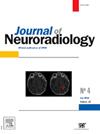Microsructural diffusion imaging of the hippocamous in treatment resistant depression
IF 3.3
3区 医学
Q2 CLINICAL NEUROLOGY
引用次数: 0
Abstract
Introduction
Severe depressive disorder is associated with smaller hippocampal volumes. We hypothesized that Neurite Orientation Dispersion and Density Imaging (NODDI) could provide in vivo evidence of decreased hippocampal neuroplasticity in patients with depression.
Methods
This cross-sectional study evaluated 43 patients with treatment-resistant depression eligible for electroconvulsive therapy and 24 controls. MRI evaluations included a 3T scan with 3DT1-weighted and multi-shell diffusion sequences (b = 200/1500/2500 s/mm², 30/45/60 directions). Q-ball, diffusion tensor, and NODDI models were used to obtain axial diffusivity (AD), radial diffusivity (RD), mean diffusivity (MD), fractional anisotropy (FA), generalized FA (GFA), neurite density index (NDI), isotropic fraction (Fiso), and orientation dispersion index (ODI). Hippocampal volumes were extracted using FreeSurfer from T1-weighted images. Pearson correlations adjusted for sex and group analyzed the relationship between age and bilateral hippocampal diffusion. Mixed-effects models assessed the impact of depression, hemisphere, sex, and age on eight diffusion metrics. Correlation matrices and group-specific correlograms analyzed diffusion metrics across both hippocampi. Principal component analysis (PCA) reduced these metrics to components explaining ‘95% of the variance.
Results
A total of 107 MRIs from patients and 24 MRIs from controls were analyzed. Hippocampal NDI was negatively correlated with age (r = -0.41, p = 0.002), while hippocampal Fiso was positively correlated (r = 0.45, p = 0.001). FA, GFA, AD, NDI, and ODI showed significant differences between patients and controls, despite comparable hippocampal volumes. PCA analysis effectively distinguished the two groups, achieving a diagnostic accuracy of 1.
Conclusion
Diffusion microstructural analyses reveal hippocampal alterations in severely depressed patients, potentially reflecting decreased neuroplasticity.
难治性抑郁症海马微结构扩散成像研究
重度抑郁症与海马体积较小有关。我们假设神经突定向弥散和密度成像(NODDI)可以提供抑郁症患者海马神经可塑性下降的体内证据。方法本横断面研究评估了43例符合电休克治疗条件的难治性抑郁症患者和24例对照组。MRI评估包括3T扫描3dt1加权和多壳扩散序列(b = 200/1500/2500 s/mm²,30/45/60个方向)。采用Q-ball、扩散张量和NODDI模型得到轴向扩散系数(AD)、径向扩散系数(RD)、平均扩散系数(MD)、分数各向异性(FA)、广义FA (GFA)、神经突密度指数(NDI)、各向同性分数(Fiso)和取向弥散指数(ODI)。使用FreeSurfer从t1加权图像中提取海马体积。Pearson相关性对性别和组进行了调整,分析了年龄和双侧海马扩散之间的关系。混合效应模型评估了抑郁、半球、性别和年龄对8个扩散指标的影响。相关矩阵和组特异性相关图分析了两个海马区的扩散指标。主成分分析(PCA)将这些指标简化为解释95%方差的成分。结果共分析了患者107张mri和对照组24张mri。海马NDI与年龄呈负相关(r = -0.41,p = 0.002),海马Fiso与年龄呈正相关(r = 0.45,p = 0.001)。尽管海马体积相当,但FA、GFA、AD、NDI和ODI在患者和对照组之间存在显著差异。PCA分析有效地区分了两组,诊断准确率为1。结论弥散显微结构分析揭示了重度抑郁症患者海马的改变,可能反映了神经可塑性的下降。
本文章由计算机程序翻译,如有差异,请以英文原文为准。
求助全文
约1分钟内获得全文
求助全文
来源期刊

Journal of Neuroradiology
医学-核医学
CiteScore
6.10
自引率
5.70%
发文量
142
审稿时长
6-12 weeks
期刊介绍:
The Journal of Neuroradiology is a peer-reviewed journal, publishing worldwide clinical and basic research in the field of diagnostic and Interventional neuroradiology, translational and molecular neuroimaging, and artificial intelligence in neuroradiology.
The Journal of Neuroradiology considers for publication articles, reviews, technical notes and letters to the editors (correspondence section), provided that the methodology and scientific content are of high quality, and that the results will have substantial clinical impact and/or physiological importance.
 求助内容:
求助内容: 应助结果提醒方式:
应助结果提醒方式:


